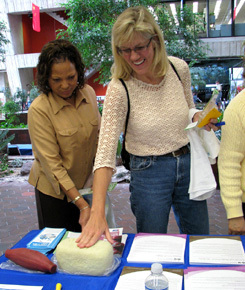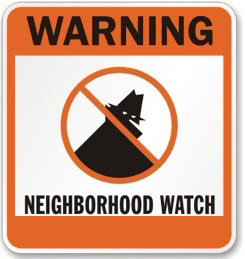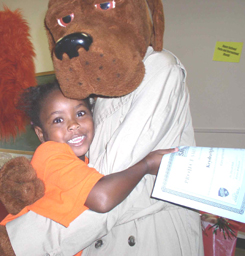The first public education program in the country on crime prevention, the campaign has inspired and directed millions of citizens to take action, individually and collectively, to reduce crime and improve the quality of life throughout the nation. - Senator Arlen Specter, 2005
In the late 1970s, most people felt there was nothing they could do about crime in their neighborhoods. However, after 30 years of McGruff people know that becoming active in the neighborhood and community can help prevent crime.
The first three public service ads starred the as yet unnamed dog, and a "Name the Dog" contest was announced in early 1980. A crime prevention officer from the New Orleans Police Department won the contest, and the public embraced McGruff the Crime Dog July 1st 1980.
The History of McGruff and the National Crime Prevention Council
Back in the late 1970s, a group of concerned citizens believed that citizens, working individually and collectively, could work with police to prevent crime. This group, consisting of government policymakers, law enforcement leaders, business people, labor leaders, and philanthropists, banded together in the name of crime prevention.
This group also understood the power of the media in spurring the public to act. In 1977, FBI Director Clarence Kelly and his assistant, John Coleman went to The Advertising Council, Inc., with a proposal for a crime prevention public service advertising campaign. Although the Ad Council turned the request down, the proposal sparked the interest of Leo Perlis, director of the AFL-CIO community service division and a member of the Ad Council's public policy committee. Perlis knew Coleman and had some contacts at the Law Enforcement Assistance Administration (LEAA), the precursor of the Office of Justice Programs at the U.S. Department of Justice. Perlis also knew Carl M. Loeb, Jr., a businessman, civic activist, and philanthropist.
In late 1977, LEAA, the National Council of Crime and Delinquency, the FBI, and the AFL-CIO formed a small planning group that included the National Sheriffs' Association and the International Association of Chiefs of Police. Two advisory boards were formed that included the 19 organizations that became the original Crime Prevention Coalition of America.
In 1978, the group submitted a proposal to LEAA outlining a public service advertising campaign that did not emphasize fear but instead sent the positive, upbeat message that crime needn't be a fact of life, that citizens could take simple actions to reduce crime risks. The ads called for individual and community action and the plan included both federal funding and private funds. LEAA approved the funding and Carl Loeb provided the initial matching funds. The Ad Council accepted the campaign and gave the assignment to the advertising agency, Dancer Fitzgerald Sample (now Saatchi & Saatchi). After conducting focus groups and speaking to residents of high-crime areas, crime prevention practitioners, and campaign founders, the creative team decided the campaign would need a unifying symbol and the ad agency created McGruff and the slogan Take A Bite Out Of Crime.
The founders named their effort the National Citizens' Crime Prevention Campaign, and in November 1979 prepared themselves to introduce the new character to the public. The first three public service ads starred the as yet unnamed dog, and a "Name the Dog" contest was announced in early 1980. A crime prevention officer from the New Orleans Police Department won the contest, and the public embraced McGruff the Crime Dog.
McGruff's early ads encouraged individuals to take common sense steps to ensure home and personal safety to reduce crime. In 1982, the campaign founders, under the leadership of Mr. Loeb, formed the National Crime Prevention Council to coordinate the McGruff campaign and promote crime prevention throughout the country. By the mid-1980s McGruff was encouraging individuals to join Neighborhood Watch and clean up streets and parks. Other messages focused on teen victimization, drug abuse prevention, violence prevention, and more. McGruff also began to turn his attention to children and asked adults to take action to prevent their children from becoming victims of violence.
Educating Your Neighbors about Crime Prevention

Many of your neighbors may benefit from a better understanding of crime prevention; it might even save their lives! McGruff the Crime Dog's 30th anniversary is an excellent opportunity to organize a crime prevention event for your community.
If an organized event is not reasonable, consider creating an educational display for your health center, community center, pool, club house, park, or wherever your neighbors congregate.
Neighborhood Link suggests the teaching tools and opportunities below:
Organize a McGruff Training in Your Area
The National Crime Prevention Council works with communities to identify goals and design and deliver one-day or multiday training sessions. It also offers extended technical assistance and facilitates comprehensive community planning initiatives. Its models have been successful in cities across the United States from Seattle, WA, to Spartanburg, SC.
Conduct Crime Prevention PowerPoint Workshops
The National Crime Prevention Council (NCPC), through the support of the Bureau of Justice Assistance, U.S. Department Justice, has developed PowerPoint presentations. Each presentation is designed to educate, increase awareness, and teach prevention strategies in workshop session approximately 60 to 90 minutes long. The presentations are also available on a CD ROM. If you would like a CD ROM, please call NCPC’s Fulfillment Center at 1-800-297-9511.
Start A Neighborhood Watch
Starting a Neighborhood Watch program in your neighborhood is not hard, but it will take a little time and some proper planning.
- First, visit the USAOnWatch.org website which is the national face of the Neighborhood Watch program. There you will find great information to help you get started.
- Determine the area you want to organize. This should be the area you consider your "neighborhood". Groups can range in size from 5 to 150 households. The larger the area, the greater the protection.
- Find neighbors to assist you. These people will form your initial group of Neighborhood Watch Volunteers. A good number would be one person per 8 to 10 households. Determine the best night of the week for a presentation. Most Neighborhood Watch presentations are held during the evening hours, Fridays and weekends are not recommended.
- Set up a free neighorhood watch website to help coordinate and communicate your efforts. Communication is the cornerstone of the Neighborhood Watch Program. Back in 1972 when the Neighborhood Watch program was launched, there was no public internet. Today however, a Neighborhood Link Website can help you create a successful Neighborhood Watch program in your neighborhood. See this article on how to use a website with the neighborhood watch program.
For More Information:

- Find Out How to Get A Free Neighborhood Watch Website
- See this other article for an overview and more resources on Neighborhood Watch-What is It?
- Step by Step Guide: How to Start a Neighborhood Association
- USA On Watch-The Face of the National Neighborhood Watch Program
- Tools and Resoures from the National Crime Prevention Council
 Print
Print Email
Email









